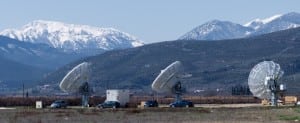Latest News
[Via Satellite 03-14-2014] Executives on the SATELLITE 2014 panel “Wireless Backhaul via Satellite: Making 3G/4G Available for Everyone” said that cellular backhaul solutions are simply not affordable for much of the world today. Most agreed that it will take close to the end of the decade before satellite can cost-effectively deliver backhaul solutions to unconnected areas. Many panelists expressed optimism, however, that this will turn into a thriving market for satellite in the near future.
“We are very bullish on the market,” said Vince Onuigbo, senior marketing director, international division, Hughes. “We see that as HTS take hold and that really, the will to reach rural areas like the effort by Google of flying balloons, and Facebook trying to reach people that otherwise wouldn’t have access, with that we think the satellite industry will continue to deliver solutions so that perhaps in the next three to four years we will see a lot more take up of satellite for backhaul solutions.”
Opinions were mixed on the magnitude of the role satellite will play, as geography remains a key influence on the type of services needed for backhaul. Voice services, though a primary reason for cellular services, drive very little of the total volume of mobile traffic. Data is the biggest driver, which makes satellite companies more inclined to focus on 3G and 4G services, but emerging markets often focus on less expensive options.
“In developed markets, [such as] Japan and the U.S., you have very large numbers of terminals, but they are femptocells feeding a single house or a single individual, and they make up a lot unit quantities here, but that relies on the high Average Revenue Per User (ARPU) we have in these regions,” explained David Burr, director of product development, O3b Networks. “That doesn’t translate to Indonesia or Pakistan. What you have going on in the emerging markets is you’ve got 2G voice services that have been deployed on macro cells, and they need to boost those up to 3G, and that’s where the bandwidth is … the satellite operators are interested in the bandwidth and the equipment providers are interested in the volume.”
This disparity in ARPU drives different preferences for cellular service. Onuigbo pointed out that cellular service only covers 10 percent of the Earth, leaving an incredible amount of room for satellite services to enter. Burr added that cellular backhaul in Brazil and Indonesia is outpacing other regions. The Asian market is developing in some locations, and Africa, he expects, will take more time. Areas of low population present a challenge because of the need for certain levels of terrestrial infrastructure for satellite. In some cases, challenges on the ground can make it difficult to provide satellite services.
“We’ve started to reach price points that are really interesting but we have one cost element that is grossly underestimated: the cost of support of the system,” said Richard Swardh, director of business development at Ericsson. “We’re talking about extreme rural areas and we’re talking about sites that are very difficult to get to and are out in the elements, many of them running on solar power.”
The panelists agreed that communications experts both in and out of the satellite industry need to work together to make cellular backhaul via satellite reach its full potential. Daniel Enns, SVP of marketing and business development at Comtech EF Data said his company allocates a significant amount of research and development funding to cellular backhaul, and Stephen Good, VP of network services product management at Intelsat spurred satellite operators to leverage their strengths, which he referred to as satellites, ground stations and spectrum rights, to grow this opportunistic market. Onuigbo echoed the aspirations of other panelists, anticipating that advances on the horizon will spell good news for reaching unconnected populations.
“HTS delivers a lot more capacity,” said Onuigbo. “It actually lowers the cost per megabit … so we see combined small cells [and] HTS whether its Ku or C by EpicNG or Ka-band, resolving the issues of practically being able to deliver these [services]. It will drive this in the right direction.”
Get the latest Via Satellite news!
Subscribe Now